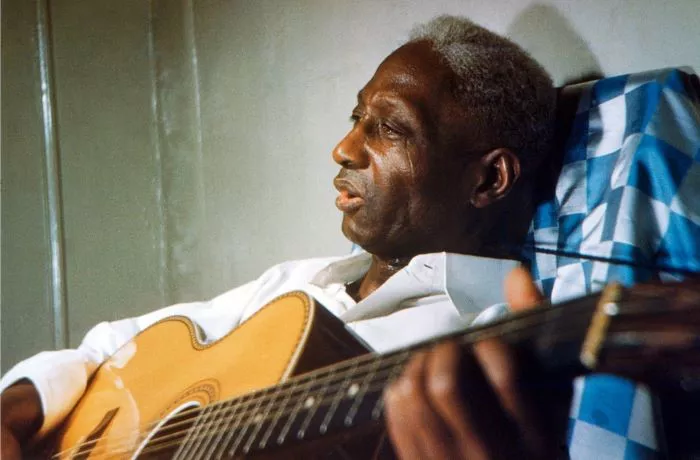Huddie William Ledbetter, known worldwide as Lead Belly, remains an enduring icon of American folk and blues music. Born in the late 19th century, likely in January 1888 or 1889, Lead Belly’s life story is as rich and vibrant as the music he created. His legacy is marked not only by his exceptional talent on the twelve-string guitar but also by the profound influence he had on the genre, introducing timeless classics such as “In the Pines,” “Goodnight, Irene,” and “Midnight Special” to the world. Let’s delve into 20 captivating facts that illuminate the life and career of this musical pioneer.
1. A Childhood in the Deep South
Lead Belly’s early years were shaped by the rugged landscape and musical traditions of the Deep South. Raised in Louisiana, his exposure to the rich tapestry of African American folk music began at a young age. This environment laid the foundation for his deep understanding and mastery of blues and folk styles, which would later define his career.
2. The Origins of “Lead Belly”
The nickname “Lead Belly” reportedly originated from an incident in which he was shot in the stomach with buckshot, leading to the belief that his stomach was as tough as lead. This nickname would become synonymous with his indomitable spirit and resilience, both in his personal life and in his music career.
3. Imprisonment and Pardon
Lead Belly’s life was tumultuous, marked by frequent clashes with the law. He served multiple prison sentences, during which he often performed for fellow inmates. It was during one such stint that he famously sang his way into a pardon from the Texas governor, who was moved by his musical talent and petitioned for his release.
4. A Master of the Twelve-String Guitar
One of Lead Belly’s most distinctive features as a musician was his virtuosity on the twelve-string guitar. This instrument allowed him to create a robust, resonant sound that complemented his powerful vocals. His skill with the twelve-string guitar set him apart from his contemporaries and solidified his reputation as a true virtuoso of his craft.
5. Famous Renditions of Traditional Songs
Among Lead Belly’s most enduring contributions are his interpretations of traditional songs such as “Cotton Fields,” “Boll Weevil,” and “Pick a Bale of Cotton.” These songs not only showcased his distinctive style but also brought attention to the rich cultural heritage of the American South, preserving these folk classics for generations to come.
6. Folklore and Mythos
Lead Belly’s life and career are steeped in folklore and mythos. Tales of his larger-than-life persona, his encounters with the law, and his ability to captivate audiences with his commanding presence have become legendary. These stories continue to add to the mystique surrounding this enigmatic musician.
7. Collaboration with Folklorists
Lead Belly’s career was significantly shaped by his collaborations with folklorists John and Alan Lomax. These partnerships resulted in extensive recordings of his music and interviews, providing invaluable insights into his creative process and preserving his repertoire for posterity.
8. Posthumous Recognition
Although Lead Belly’s life was marked by hardships and challenges, his musical legacy continues to receive widespread recognition. He was posthumously inducted into the Rock and Roll Hall of Fame in 1988 and remains a revered figure in the pantheon of American music.
9. Rediscovery in the Folk Revival
During the folk revival of the 1950s and 1960s, Lead Belly’s music experienced a resurgence in popularity. Artists such as Pete Seeger and Woody Guthrie championed his songs, introducing them to a new generation of socially conscious listeners.
Conclusion
Lead Belly’s journey from the Deep South to international acclaim is a testament to the power of music to transcend barriers and inspire change. His contributions to folk and blues music have left an indelible mark on the cultural landscape, influencing generations of artists and resonating with audiences across the globe. As we reflect on his life and legacy, Lead Belly’s enduring appeal reminds us of the timeless quality of great music and the profound impact it can have on society.
FAQs:
1. Is Lead Belly in the Hall of Fame?
Lead Belly was inducted into the Blues Hall of Fame (1986) and the Rock and Roll Hall of Fame (1988). In 2015 the Smithsonian Institution’s Smithsonian Folkways record label released a five-CD box set of his recordings.
2. Why was Lead Belly important?
Huddie “Lead Belly” Ledbetter (1888-1949) was one of the most important folk musicians of the twentieth century. He was a seminal figure in the development of Folkways Records, and his work played a major role in the establishment of Folkways at the Smithsonian.
3. Where was Lead Belly buried?
In 1949, at the age of 61, Lead Belly would lose his life to Lou Gehrig’s disease. His body was brought back to Mooringsport, Louisiana and buried at Shiloh Baptist Church.
Related topics:


